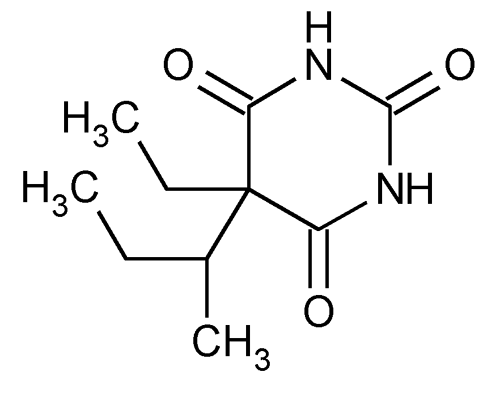Butabarbital
2,4,6(1H,3H,5H)-Pyrimidinetrione, 5-ethyl-5-(1-methylpropyl)-.
5-sec-Butyl-5-ethylbarbituric acid
» Butabarbital contains not less than 98.5 percent and not more than 101.0 percent of C10H16N2O3, calculated on the dried basis.
Packaging and storage—
Preserve in tight containers.
Loss on drying  731
731 —
Dry it at 105
—
Dry it at 105 for 2 hours: it loses not more than 1.0% of its weight.
for 2 hours: it loses not more than 1.0% of its weight.
Residue on ignition  281
281 :
not more than 0.1%.
:
not more than 0.1%.
Chromatographic purity—
Standard solutions—
Dissolve a quantity of USP Butabarbital RS in a mixture of chloroform and methanol (1:1) to obtain a solution having a concentration of 4.0 mg per mL (Standard solution A). Dilute 1.0 mL of Standard solution A with a mixture of chloroform and methanol (1:1) to 10.0 mL, and mix (Standard solution B).
Test solution—
Dissolve a quantity of Butabarbital in a mixture of chloroform and methanol (1:1) to obtain a solution having a concentration of 40 mg per mL.
Procedure—
Proceed as directed for Procedure in the test for Chromatographic purity under Butabarbital Sodium.
Assay—
Internal standard solution—
Transfer about 400 mg of tetracosane to a 200-mL volumetric flask, add chloroform to volume, and mix.
Standard preparation—
Transfer about 200 mg of USP Butabarbital RS, accurately weighed, to a 100-mL volumetric flask, add chloroform to volume, and mix. Transfer 10.0 mL of the resulting solution to a 50-mL volumetric flask, add 10.0 mL of Internal standard solution, and mix to obtain a solution having a known concentration of about 1.0 mg of USP Butabarbital RS per mL.
Assay preparation—
Transfer about 200 mg of Butabarbital, accurately weighed, to a 100-mL volumetric flask, add chloroform to volume, and mix. Transfer 10.0 mL of the resulting solution to a 50-mL volumetric flask, add 10.0 mL of Internal standard solution, and mix.
Chromatographic system
(see Chromatography  621
621 )—The gas chromatograph is equipped with a flame-ionization detector and a 4-mm × 1.8-m column packed with 10% phase G37 on support S1AB. The column temperature is maintained at about 260
)—The gas chromatograph is equipped with a flame-ionization detector and a 4-mm × 1.8-m column packed with 10% phase G37 on support S1AB. The column temperature is maintained at about 260 , the injection port at about 260
, the injection port at about 260 , and the detector block at about 300
, and the detector block at about 300 . Dry nitrogen is used as the carrier gas at a flow rate of about 50 mL per minute. Chromatograph the Standard preparation, and record the peak responses as directed for Procedure: the tailing factors for the analyte and internal standard peaks are not more than 1.3 and 1.2, respectively; the resolution, R, between the analyte and internal standard peaks is not less than 3.0; and the relative standard deviation for replicate injections is not more than 1.0%.
. Dry nitrogen is used as the carrier gas at a flow rate of about 50 mL per minute. Chromatograph the Standard preparation, and record the peak responses as directed for Procedure: the tailing factors for the analyte and internal standard peaks are not more than 1.3 and 1.2, respectively; the resolution, R, between the analyte and internal standard peaks is not less than 3.0; and the relative standard deviation for replicate injections is not more than 1.0%.
Procedure—
Separately inject equal volumes (about 2 µL) of the Standard preparation and the Assay preparation into the chromatograph, record the chromatograms, and measure the responses for the major peaks. The relative retention times are about 0.6 for butabarbital and 1.0 for tetracosane. Calculate the quantity, in mg, of C10H16N2O3 in the portion of Butabarbital taken by the formula:
200C(RU / RS)
in which C is the concentration, in mg per mL, of USP Butabarbital RS in the Standard preparation; and RU and RS are the peak response ratios obtained from the Assay preparation and the Standard preparation, respectively.
Auxiliary Information—
Please check for your question in the FAQs before contacting USP.
Chromatographic Column—
| Topic/Question | Contact | Expert Committee |
| Monograph | Ravi Ravichandran, Ph.D.
Senior Scientist 1-301-816-8330 |
(MDPP05) Monograph Development-Psychiatrics and Psychoactives |
| Reference Standards | Lili Wang, Technical Services Scientist 1-301-816-8129 RSTech@usp.org |
USP32–NF27 Page 1727
Chromatographic columns text is not derived from, and not part of, USP 32 or NF 27.
